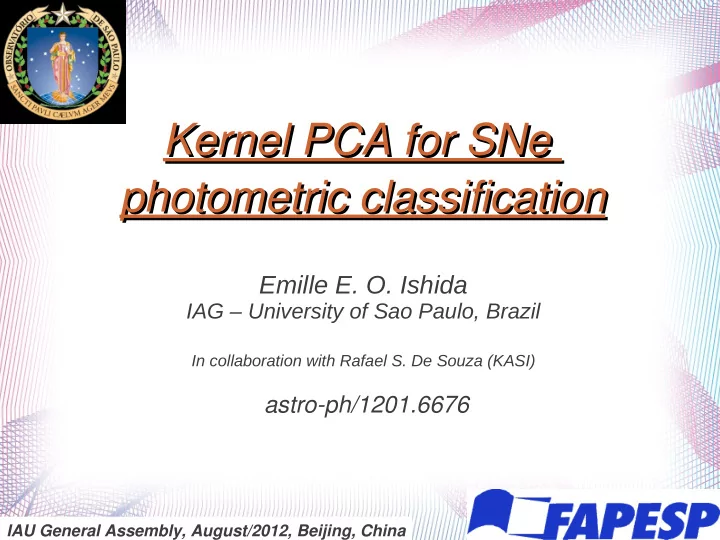

Kernel PCA for SNe Kernel PCA for SNe photometric classification photometric classification Emille E. O. Ishida IAG – University of Sao Paulo, Brazil In collaboration with Rafael S. De Souza (KASI) astro-ph/1201.6676 IAU General Assembly, August/2012, Beijing, China
1. The problem 1. The problem Ironically... We have too much data! T ype Ia SN surveys are not able to provide complete spectroscopic follow up IAU General Assembly, August/2012, Beijing, China
1. The problem 1. The problem IIP IAU General Assembly, August/2012, Beijing, China
1. The problem 1. The problem Which one is a Ia? IAU General Assembly, August/2012, Beijing, China
2. Principal Component Analysis (PCA) 2. Principal Component Analysis (PCA) Dimensionality reduction technique Look for directions that maximizes variance http://web.media.mit.edu/~tristan/phd/dissertation/figures/PCA.jpg IAU General Assembly, August/2012, Beijing, China
2. PCA limitations 2. PCA limitations Is not designed to capture non-linear structure Does not care about labels IAU General Assembly, August/2012, Beijing, China
2. PCA extensions 2. PCA extensions Sometimes, going to higher dimensions might solve the problem IAU General Assembly, August/2012, Beijing, China
2.The kernel trick 2.The kernel trick First natural choice - Gaussian kernel IAU General Assembly, August/2012, Beijing, China
2.The kernel trick 2.The kernel trick First natural choice - Gaussian kernel IAU General Assembly, August/2012, Beijing, China
3. kPCA applied to SNe classification 3. kPCA applied to SNe classification Classification Classification THE Nearest Neighbor (1NN) IAU General Assembly, August/2012, Beijing, China
3. kPCA applied to SNe classification 3. kPCA applied to SNe classification P o s t - S A N f t P e r C s C e l s e a c m t i o p n l e c u t s FoM ~0.60 SC ~91% Selection cuts: {-3,+24} in r-band At least 3 obs with SNR>5 in each band IAU General Assembly, August/2012, Beijing, China
3. kPCA applied to SNe classification 3. kPCA applied to SNe classification Our results Our results Results from the Supernova Photometric Classification Challenge (Kessler et al., 2010) IAU General Assembly, August/2012, Beijing, China
3. kPCA applied to SNe classification 3. kPCA applied to SNe classification Our results Our results No hostZ hostZ average purity: 75% average purity: 75% Same result as winner SNPCC (76%), without using host redshift information Results from the Supernova Photometric Classification Challenge Better result in intermediate redshift (Kessler et al., 2010) IAU General Assembly, August/2012, Beijing, China
4. Conclusions 4. Conclusions 1. SNe photometric classification is not a future issue.. it is already here! 2. kPCA is a powerfull tool, mainly if we are interested in a high quality purity in intermediate redshifts. 3. There is no need of enviromental, redshift or astrophysical hypothesis 4. Great potential in detecting previously non-observed objects: Application to PISN search IAU General Assembly, August/2012, Beijing, China
Recommend
More recommend